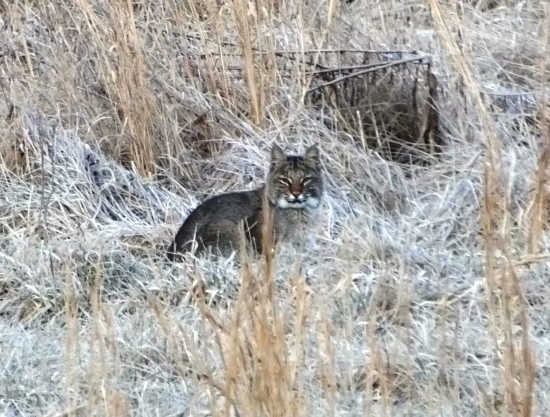http://www.dailystatesman.com/story/2168492.html
Sightings prove bobcats have presence in southeast Missouri
Saturday, February 21, 2015
Photo courtesy of PETER REA/USFWS - Peter Rea, Refuge
Ranger at Mingo Wildlife Refuge near Puxico, photographed
this bobcat around 8 a.m. on Feb. 3 in the refuge along Bluff
Road in the fields close to Flatbanks Road.
Ranger at Mingo Wildlife Refuge near Puxico, photographed
this bobcat around 8 a.m. on Feb. 3 in the refuge along Bluff
Road in the fields close to Flatbanks Road.
According to Rea, a daytime sighting of a bobcat is rare. They are nocturnal animals, preferring heavy forest cover with considerable underbrush, making Mingo an ideal setting for the animal.
"There is a healthy population of bobcats on the refuge," Rea says. "The refuge provides ideal habitat with the rocky bluffs, open field and forested areas. We have trail cameras out on the refuge and frequently get pictures of bobcats. They're extremely stealthy, and for that reason are not often seen by visitors."
According to the Missouri Department of Conservation, bobcats used to live primarily in the Ozarks and the Bootheel, but over the past few decades have expanded westward and northward. They are considered one of the most common wild cats in North America, with an estimated 1,000,000 from southern Canada to northern Mexico.
A mature bobcat can be from 18 all the way to 50 inches in length and weigh from eight to nearly 50 pounds. They are of yellowish to reddish-brown in color, streaked and spotted with black. They have long hind legs, a short, broad face and a short "bobbed" tail that is generally from three to eight inches in length.
"The one pictured has a number of black streaks, so it appears darker," Rea explains. "Bobcats molt twice each year, and the summer coat is often more of a reddish color while the winter coat is more gray in color," he adds.
It is estimated that a bobcat will travel between three and seven miles nightly. They begin to mate in December and that can extend all the way into June, with the peak mating season in March. They have a 50-70 day gestation period, and two or three kittens are considered a normal litter.
Rea says the bobcat is not an aggressive animal. "They tend to be shy animals that avoid human interaction," he notes.
Rea says he has not heard of any livestock attacks around the refuge that are suspected to be by a bobcat.
"Their food source is plentiful here," he affirms. "Their main food source includes rabbits, mice, rats, squirrels and other small mammals, as well as opossums, wild turkeys, deer and other meats."
There is an established hunting season for bobcat in Missouri. Primary next season in begins on Nov. 15, 2015 and runs through Jan. 31, 2016. There are no restrictions as to how many bobcats may be taken during the designated period.
---------------------------------------------------------------------------------------
William R. Clark, Ph.D. & Todd Gosselink, Ph.D.IOWA STATE UNIVERSITYIowa Department of Natural Resources |
|











No comments:
Post a Comment